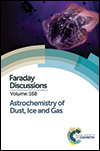Application of a diffusion–desorption rate equation model in astrochemistry
Abstract
Desorption and diffusion are two of the most important processes on interstellar grain surfaces; knowledge of them is critical for the understanding of chemical reaction networks in the interstellar medium (ISM). However, a lack of information on desorption and diffusion is preventing further progress in astrochemistry. To obtain desorption energy distributions of molecules from the surfaces of ISM-related materials, one usually carries out adsorption–desorption temperature programmed desorption (TPD) experiments, and uses rate equation models to extract desorption energy distributions. However, the often-used rate equation models fail to adequately take into account diffusion processes and thus are only valid in situations where adsorption is strongly localized. As adsorption–desorption experiments show that adsorbate molecules tend to occupy deep adsorption sites before occupying shallow ones, a diffusion process must be involved. Thus, it is necessary to include a diffusion term in the model that takes into account the morphology of the surface as obtained from analyses of TPD experiments. We take the experimental data of CO desorption from the MgO(100) surface and of D2 desorption from amorphous solid water ice as examples to show how a diffusion–desorption rate equation model explains the redistribution of adsorbate molecules among different adsorption sites. We extract distributions of desorption energies and diffusion energy barriers from TPD profiles. These examples are contrasted with a system where adsorption is strongly localized – HD from an amorphous silicate surface. Suggestions for experimental investigations are provided.
- This article is part of the themed collection: Astrochemistry of Dust, Ice and Gas

 Please wait while we load your content...
Please wait while we load your content...